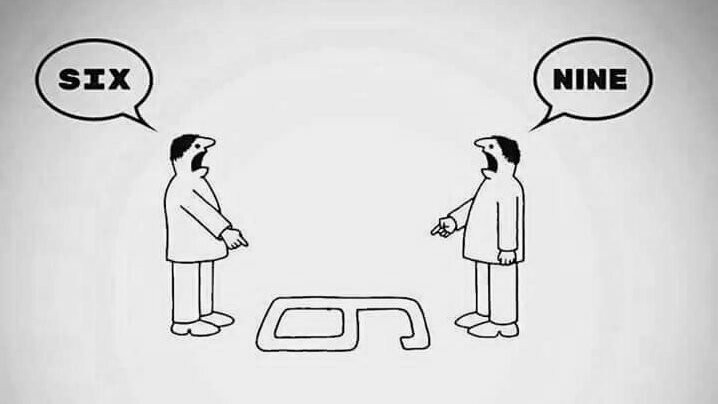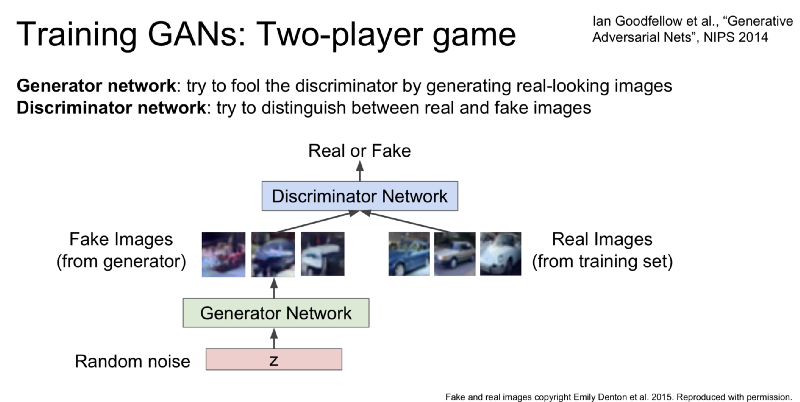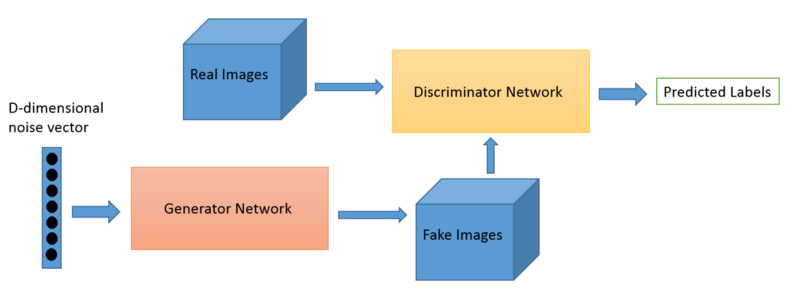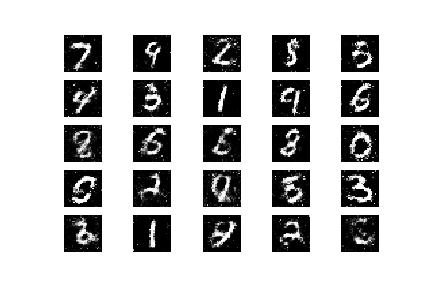Hand Written Digit Generation with a G.A.N

Photo by Eridy Lukau
Goal
This is not the 1st ambition of this challenge, anyway generation of new digits can also be interesting !
Here i’m going to create a GAN model, to train this model, and then use it to generate new “handwritten” digits…
import random
import numpy as np
import pandas as pd
import seaborn as sns
import matplotlib.pyplot as plt
import matplotlib.image as mpimg
#from keras.datasets import mnist
from tensorflow.keras.utils import to_categorical
from tensorflow.keras.callbacks import EarlyStopping, TensorBoard
from tensorflow.keras.preprocessing.image import ImageDataGenerator, array_to_img, img_to_array, load_img
from tensorflow.keras.layers import Input, Dense, Reshape, Flatten, Dropout, MaxPooling2D, Conv2D, UpSampling2D
from tensorflow.keras.layers import BatchNormalization, Activation, ZeroPadding2D
from tensorflow.keras.layers import LeakyReLU
from tensorflow.keras.models import Sequential, Model
from tensorflow.keras.optimizers import Adam
Credits
Thanks to Antoine Meicler and Vincent Vandenbussche for all the things you teach me !
Data preparation
We’ll use the famous MNIST data intended to jearn computer vision fundamentals.
df = pd.read_csv('../input/train.csv')
df.head()
| label | pixel0 | pixel1 | pixel2 | pixel3 | pixel4 | pixel5 | pixel6 | pixel7 | pixel8 | ... | pixel774 | pixel775 | pixel776 | pixel777 | pixel778 | pixel779 | pixel780 | pixel781 | pixel782 | pixel783 | |
|---|---|---|---|---|---|---|---|---|---|---|---|---|---|---|---|---|---|---|---|---|---|
| 0 | 1 | 0 | 0 | 0 | 0 | 0 | 0 | 0 | 0 | 0 | ... | 0 | 0 | 0 | 0 | 0 | 0 | 0 | 0 | 0 | 0 |
| 1 | 0 | 0 | 0 | 0 | 0 | 0 | 0 | 0 | 0 | 0 | ... | 0 | 0 | 0 | 0 | 0 | 0 | 0 | 0 | 0 | 0 |
| 2 | 1 | 0 | 0 | 0 | 0 | 0 | 0 | 0 | 0 | 0 | ... | 0 | 0 | 0 | 0 | 0 | 0 | 0 | 0 | 0 | 0 |
| 3 | 4 | 0 | 0 | 0 | 0 | 0 | 0 | 0 | 0 | 0 | ... | 0 | 0 | 0 | 0 | 0 | 0 | 0 | 0 | 0 | 0 |
| 4 | 0 | 0 | 0 | 0 | 0 | 0 | 0 | 0 | 0 | 0 | ... | 0 | 0 | 0 | 0 | 0 | 0 | 0 | 0 | 0 | 0 |
5 rows × 785 columns
df['label'].unique()
array([1, 0, 4, 7, 3, 5, 8, 9, 2, 6])
sns.countplot(df['label'])
<matplotlib.axes._subplots.AxesSubplot at 0x7f5ec4138048>

They are 10 different classes which seem to be balanced.
X_train, y_train = np.array(df.iloc[:, 1:]), np.array(df['label'])
X_train.shape, y_train.shape
((42000, 784), (42000,))
img_width, img_height, channels = 28, 28, 1
X_train = X_train.reshape(42000, img_width, img_height, channels)
X_train.shape
(42000, 28, 28, 1)
# display 5 randomly choosen images
plt.figure(figsize=(12, 5))
for i in range(1, 6):
plt.subplot(1, 5, i)
num = random.randint(0, X_train.shape[0])
plt.imshow(X_train[num].reshape(img_width, img_height), cmap="gray_r")
plt.axis('off')
label = 'Label' + str(y_train[num])
plt.title(label)
plt.show()

type(X_train[0, 0, 0, 0])
numpy.int64
# Rescale -1 to 1 and format the X_train dataset
X_train = (X_train.astype(np.float32) - 127.5) / 127.5
#X_train = np.expand_dims(X_train, axis=3)
Don’t forget that the MNIST dataset is grayscale so it contains only one channel.
Keras expects input images to have 3 dimensions even if there is only one channel.
The GAN architecture
Theory

Summary form Towardsdatascience
We would like to provide a set of images as an input, and generate samples based on them as an output.
Input Images -> GAN -> Output Samples
With the following problem definition, GANs fall into the Unsupervised Learning bucket because we are not going to feed the model with labeled data.
The underlying idea behind GAN is that it contains two neural networks that compete against each other in a zero-sum game framework, i.e. generator and a discriminator.

Generator The Generator takes random noise as an input and generates samples as an output. It’s goal is to generate such samples that will fool the Discriminator to think that it is seeing real images while actually seeing fakes. We can think of the Generator as a counterfeit.
Discriminator Discriminator takes both real images from the input dataset and fake images from the Generator and outputs a verdict whether a given image is legit or not. We can think of the Discriminator as a policeman trying to catch the bad guys while letting the good guys free.
Minimax Representation If we think once again about Discriminator’s and Generator’s goals, we can see that they are opposing each other. Discriminator’s success is a Generator’s failure and vice-versa. That is why we can represent GANs framework more like Minimax game framework rather than an optimization problem.
GAN data flow can be represented as in the following diagram.

The Generator
The first step is to build a generator. We start with an input noise shape of size 100. Then, we create a sequential model to increase the size of the data up to 1024, before reshaping the data back to the input image shape.
Each layer will be made of:
- A Dense layer (sizes 256, 512, 1024 in order)
- A LeakyRelu activation with alpha = 0.2
- A Batch normalization (momentum = 0.8)
img_shape = (img_width, img_height, channels)
def build_generator():
# Input Data
noise_shape = (100,)
noise = Input(shape=noise_shape)
# Create the sequential model
model = Sequential()
# Build the first layer
model.add(Dense(256, input_shape=noise_shape))
model.add(LeakyReLU(alpha=0.2))
model.add(BatchNormalization(momentum=0.8))
# Second layer
model.add(Dense(512))
model.add(LeakyReLU(alpha=0.2))
model.add(BatchNormalization(momentum=0.8))
# Third layer
model.add(Dense(1024))
model.add(LeakyReLU(alpha=0.2))
model.add(BatchNormalization(momentum=0.8))
# Flatten and reshape
model.add(Dense(np.prod(img_shape), activation='tanh'))
model.add(Reshape(img_shape))
# Get model summary
img = model(noise)
model.summary()
return Model(noise, img)
Compilation of the Generator and add an Adam optimizer as advised.
optimizer = Adam(0.0002, 0.5)
generator = build_generator()
generator.compile(loss='binary_crossentropy', optimizer=optimizer)
_________________________________________________________________
Layer (type) Output Shape Param #
=================================================================
dense_14 (Dense) (None, 256) 25856
_________________________________________________________________
leaky_re_lu_11 (LeakyReLU) (None, 256) 0
_________________________________________________________________
batch_normalization_v1_9 (Ba (None, 256) 1024
_________________________________________________________________
dense_15 (Dense) (None, 512) 131584
_________________________________________________________________
leaky_re_lu_12 (LeakyReLU) (None, 512) 0
_________________________________________________________________
batch_normalization_v1_10 (B (None, 512) 2048
_________________________________________________________________
dense_16 (Dense) (None, 1024) 525312
_________________________________________________________________
leaky_re_lu_13 (LeakyReLU) (None, 1024) 0
_________________________________________________________________
batch_normalization_v1_11 (B (None, 1024) 4096
_________________________________________________________________
dense_17 (Dense) (None, 784) 803600
_________________________________________________________________
reshape_1 (Reshape) (None, 28, 28, 1) 0
=================================================================
Total params: 1,493,520
Trainable params: 1,489,936
Non-trainable params: 3,584
_________________________________________________________________
The Discriminator
Now let’s build the discriminator. It takes an input that has the shape of the image. The steps are the following :
- Declaration of the Sequential model
- Flatten the images (with input shape = image shape)
- Addition of a Dense layer of 512 and a Leaky Relu (0.2)
- Addition of a Dense layer of 256 and a Leaky Relu (0.2)
- Addition of a Dense layer of size 1. What activation function would you use ?
def build_discriminator():
img = Input(shape=img_shape)
# Create the sequential model
model = Sequential()
# Flatten the images taken as inputs
model.add(Flatten(input_shape=img_shape))
# First layer
model.add(Dense(512))
model.add(LeakyReLU(alpha=0.2))
# Second layer
model.add(Dense(256))
model.add(LeakyReLU(alpha=0.2))
# Last layer, return either 0 or 1
model.add(Dense(1, activation='sigmoid'))
# Get model summary
validity = model(img)
model.summary()
return Model(img, validity)
Compilation of the discriminator. (Observe the metric we are using)
discriminator = build_discriminator()
discriminator.compile(
loss='binary_crossentropy',
optimizer=optimizer,
metrics=['accuracy'])
_________________________________________________________________
Layer (type) Output Shape Param #
=================================================================
flatten_1 (Flatten) (None, 784) 0
_________________________________________________________________
dense_18 (Dense) (None, 512) 401920
_________________________________________________________________
leaky_re_lu_14 (LeakyReLU) (None, 512) 0
_________________________________________________________________
dense_19 (Dense) (None, 256) 131328
_________________________________________________________________
leaky_re_lu_15 (LeakyReLU) (None, 256) 0
_________________________________________________________________
dense_20 (Dense) (None, 1) 257
=================================================================
Total params: 533,505
Trainable params: 533,505
Non-trainable params: 0
_________________________________________________________________
Build the whole GAN model
It is time to build the entire GAN model. This operation can be achieved in 4 major steps :
- Declare the input
- Set the image as the result of the generator of the input
- Set the output as the result of the discriminator of the generated image
- Define and compile the model
# 1. Declare input of size (100, )
z = Input(shape=(100,))
# 2. Define the generated image from the input - Use the generator model compiled above
img = generator(z)
# 3. Define the output from the image - Use the discriminator model compiled above
valid = discriminator(img)
# For the combined model, only train the generator
discriminator.trainable = False
# 4.Combined model - by defining the input and the output
combined = Model(z, valid)
# Once created, compilation of the whole model
combined.compile(loss='binary_crossentropy', optimizer=optimizer)
Summary of the new model created.
combined.summary()
_________________________________________________________________
Layer (type) Output Shape Param #
=================================================================
input_9 (InputLayer) (None, 100) 0
_________________________________________________________________
model_3 (Model) (None, 28, 28, 1) 1493520
_________________________________________________________________
model_4 (Model) (None, 1) 533505
=================================================================
Total params: 2,027,025
Trainable params: 1,489,936
Non-trainable params: 537,089
_________________________________________________________________
Function that is used to save generated images once in a while.
def save_imgs(epoch):
# Predict from input noise
r, c = 5, 5
noise = np.random.normal(0, 1, (r * c, 100))
gen_imgs = generator.predict(noise)
# Rescale images 0 - 1
gen_imgs = 0.5 * gen_imgs + 0.5
# Subplots
fig, axs = plt.subplots(r, c)
cnt = 0
for i in range(r):
for j in range(c):
axs[i,j].imshow(gen_imgs[cnt, :,:,0], cmap='gray')
axs[i,j].axis('off')
cnt += 1
fig.savefig("../output/mnist_%d.png" % epoch)
plt.close()
Model Training
First of all, we set :
- the number of epochs the model will train to 15’000
- the batch size to 64
- the interval at which we save the images to 1000
epochs = 15000
batch_size = 64
save_interval = 1000
half_batch = int(batch_size / 2)
The following code is complete. Try to understand the different steps, debug potential errors from your previous code and compile it.
d_loss_hist = []
g_loss_hist = []
d_acc = []
for epoch in range(epochs):
# ---------------------
# Train Discriminator
# ---------------------
# Pick 50% of sample images
idx = np.random.randint(0, X_train.shape[0], half_batch)
imgs = X_train[idx]
# Generate 50% of new images
noise = np.random.normal(0, 1, (half_batch, 100))
gen_imgs = generator.predict(noise)
# Train discriminator on real images with label 1
d_loss_real = discriminator.train_on_batch(imgs, np.ones((half_batch, 1)))
# Train discriminator on fake images with label 0
d_loss_fake = discriminator.train_on_batch(gen_imgs, np.zeros((half_batch, 1)))
# Loss of discriminator = Mean of Real and Fake loss
d_loss = 0.5 * np.add(d_loss_real, d_loss_fake)
d_loss_hist.append(d_loss[0])
d_acc.append(d_loss[1])
# ---------------------
# Train Generator
# ---------------------
# The generator wants the discriminator to label the generated samples as valid (ones)
noise = np.random.normal(0, 1, (batch_size, 100))
valid_y = np.array([1] * batch_size)
# Train the generator
g_loss = combined.train_on_batch(noise, valid_y)
g_loss_hist.append(g_loss)
# Print the progress
print ("%d [D loss: %f, acc.: %.2f%%] [G loss: %f]" % (epoch, d_loss[0], 100*d_loss[1], g_loss))
if epoch % save_interval == 0:
save_imgs(epoch)
WARNING:tensorflow:Discrepancy between trainable weights and collected trainable weights, did you set `model.trainable` without calling `model.compile` after ?
WARNING:tensorflow:Discrepancy between trainable weights and collected trainable weights, did you set `model.trainable` without calling `model.compile` after ?
0 [D loss: 0.374034, acc.: 81.25%] [G loss: 0.722144]
1 [D loss: 0.339896, acc.: 81.25%] [G loss: 0.761038]
2 [D loss: 0.347759, acc.: 81.25%] [G loss: 0.847006]
3 [D loss: 0.334043, acc.: 81.25%] [G loss: 0.955707]
4 [D loss: 0.314673, acc.: 87.50%] [G loss: 1.075714]
5 [D loss: 0.272925, acc.: 90.62%] [G loss: 1.225585]
6 [D loss: 0.217444, acc.: 98.44%] [G loss: 1.306365]
7 [D loss: 0.205875, acc.: 100.00%] [G loss: 1.505471]
8 [D loss: 0.172943, acc.: 100.00%] [G loss: 1.633218]
9 [D loss: 0.144670, acc.: 100.00%] [G loss: 1.828782]
10 [D loss: 0.122131, acc.: 100.00%] [G loss: 1.955405]
[...]
6109 [D loss: 0.684567, acc.: 51.56%] [G loss: 0.829212]
6110 [D loss: 0.663053, acc.: 64.06%] [G loss: 0.871625]
6111 [D loss: 0.644414, acc.: 56.25%] [G loss: 0.860022]
6112 [D loss: 0.679890, acc.: 56.25%] [G loss: 0.843184]
6113 [D loss: 0.636259, acc.: 60.94%] [G loss: 0.836715]
6114 [D loss: 0.683264, acc.: 64.06%] [G loss: 0.868666]
6115 [D loss: 0.617825, acc.: 70.31%] [G loss: 0.858657]
--------------------------------------------------------------------------- ---
Creation of new digits
We now have all the elements required to generate new samples. What are according to you :
- the steps to generate new samples ?
- the part of the network we re-use ?
You are now asked to generate and visualize new samples from the steps you defined above. Pay attention when plotting generated images to :
- rescale the images between 0 and 1 (as done previously)
- reshape the generated image to 28*28
noise = np.random.normal(0, 1, (1, 100))
gen_imgs = generator.predict(noise)
gen_imgs = 0.5 * gen_imgs + 0.5
plt.imshow(gen_imgs.reshape(28,28), cmap="gray_r")
plt.axis("off")
plt.show()
Here are the 1st digits created, it’s only noise…

After 3000 iterations…the shape is here

And after 6000 iterations, it’s much better



